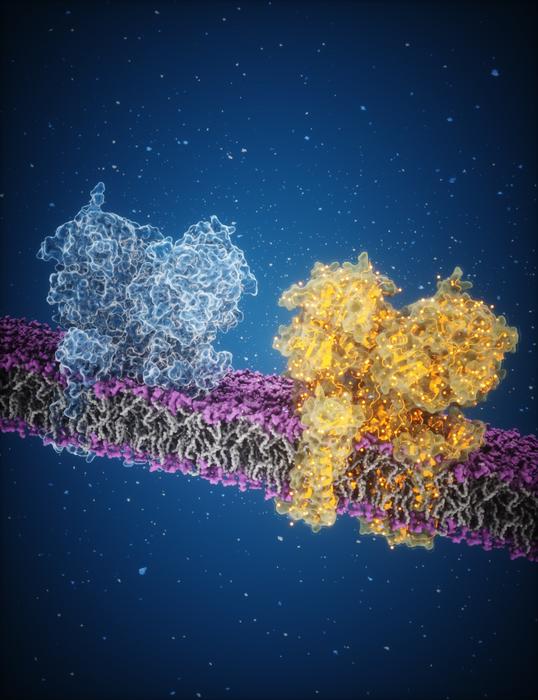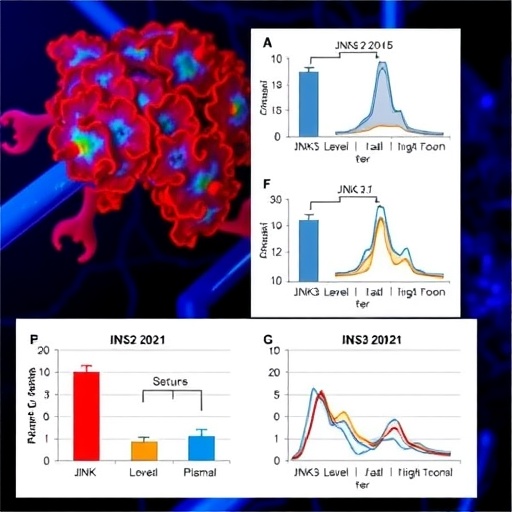
In the intricate dance of neuronal communication, scholars are continuously probing the depths of how our brain cells exchange vital information through chemical signals. The latest breakthrough in this domain has emerged from the esteemed Johns Hopkins Medicine, where researchers have employed an advanced microscopy technique to unveil a more precise understanding of glutamate, one of the brain’s most pivotal signaling molecules. This molecule plays an instrumental role in neuron-to-neuron interactions, specifically through a type of receptor known as the AMPA receptor. The implications of these findings are profound, potentially steering the development of innovative pharmacological remedies aimed at treating a variety of neurological conditions, including epilepsy and various cognitive disorders.
Glutamate is ubiquitous in the synaptic clefts between neurons, functioning as the primary neurotransmitter that dictates synaptic transmission by activating receptors located on the postsynaptic neuron. Among these, AMPA receptors hold prominence due to their crucial role in fast synaptic transmission and plasticity, which is the underlying mechanism of learning and memory. Researchers have long been intrigued by these receptors, investigating how their ability to interact with glutamate leads to the influx of charged particles that trigger electrical signaling between neurons. The comprehension of this process could reveal untapped avenues for therapeutic intervention and shed light on the biochemical underpinnings of various neurological disorders.
The novel study, spearheaded by Edward Twomey, Ph.D., at Johns Hopkins University School of Medicine, delves into the intricate workings of AMPA receptors in a manner previously unattainable. The scholars employed a cryo-electron microscope (cryo-EM), an ultra-high-resolution imaging tool enabling scientists to observe biological structures at near-atomic resolution. This cutting-edge technique was deployed to scrutinize the transient interactions between AMPA receptors and glutamate during critical steps in synaptic signaling. The researchers ascertained that these interactions allow receptor channels to undergo conformational changes that enable the selective entry of specific ions, which in turn facilitate the electric signals that are crucial for neuronal communication.
What sets this research apart is the methodological innovation surrounding how the AMPA receptors were studied. Traditionally, experiments have necessitated studying samples under cryogenic conditions, as colder environments stabilize cellular structures effectively. In this study, however, Twomey’s team discovered that performing their observations at physiological body temperature—approximately 37 degrees Celsius—enhanced the activity and responses of both AMPA receptors and glutamate. This approach yielded a richer dataset and more informative imagery of the receptor-ligand interaction, thereby revealing intricate dynamics that could significantly shape our grasp of synaptic transmission.
The researchers began by isolating AMPA receptors from lab-cultured human embryonic cells, a standard procedure in neuroscience research that allows for the production of essential proteins. These receptors were then heated to physiological temperatures before exposure to glutamate; this carefully orchestrated procedure enabled real-time observation of how glutamate molecules interacted with the receptor channels. Upon exposure, the team immediately flash-froze the receptors to capture their state at the crucial juncture of channel activation and ligand binding. This amalgamation of artistic precision and scientific rigor culminated in obtaining over one million distinct images, which were painstakingly analyzed to understand the molecular choreography underlying neurotransmission.
The results were illuminating: they established a conceptual understanding that glutamate functions much like a key fitting into a lock. When glutamate binds to AMPA receptors, the receptors undergo a “clamshell-like” transformation that effectively pulls open the channel, allowing charged ions to flow through. This phenomenon elucidates how neurotransmission is not merely a passive process but instead an active engagement facilitated by the structural dynamism of the receptor upon ligand binding. The researchers observed that this unlocking mechanism is critical for the generation of electrical signals essential for neural communication, thereby underscoring the receptor-ligand interaction’s pivotal role in our cognitive abilities.
Earlier work led by Twomey had revealed that certain pharmacological agents, such as perampanel—which is utilized in the treatment of epilepsy—function by obstructing the AMPA receptor channels. These drugs act as “doorstoppers,” effectively preventing the channel from opening fully, thereby curtailing excessive neuronal activity often seen in individuals afflicted with epilepsy. The articulation of this specific locking mechanism further accentuates the potential for developing new pharmacotherapies that can modulate AMPA receptor activity, either intensifying or inhibiting synaptic communications to remedy pathological conditions.
Future endeavors inspired by these findings may lead to the design of novel drugs tailored to target AMPA receptors in a specialized manner, thereby facilitating a finer balance in neurotransmission. This could revolutionize treatments for a range of neurological diseases, offering greater specificity and fewer side effects than current general approaches. Moreover, understanding the mechanics of AMPA receptor function could aid in crafting therapeutics that enhance cognitive function in diseases marked by neurodegeneration or cognitive decline.
These advancements not only enrich our scientific lexicon but also present new paradigms for understanding the human brain’s vast complexity. Each micro-discovery serves to elucidate the biological architecture that enables our brains to process information, adapt, and respond to environments. The intricate network of communication between neurons symbolizes a grand orchestration that, when deciphered, holds the potential to unravel the mysteries of brain function and pave the way for unprecedented therapeutic opportunities.
Behind this monumental research stand a team of dedicated scientists, including Anish Kumar Mondal from Johns Hopkins and collaborators Elisa Carrillo and Vasanthi Jayaraman from UTHealth Houston. Their concerted efforts reflect the collaborative spirit essential for scientific advancement. With the National Institutes of Health and associated research foundations backing this inquiry, the groundwork has been laid for ongoing explorations into the microscopic intricacies that uphold our cognitive realities. This illuminating study not only advances the field of neuroscience but also serves to inspire future generations of researchers dedicated to unraveling the complexities of the human brain.
As we push the boundaries of what’s conceivable in neuroscience, findings like these not only spark the imagination but also plant the seeds for future discoveries that could redefine our understanding of the brain, its functions, and how we might manipulate them for therapeutic gain. As researchers continue to dissect these molecular interactions, the hope remains that this knowledge will contribute to innovative treatments, ultimately addressing some of the most challenging neurological conditions that afflict humanity.
Subject of Research: Glutamate and AMPA receptor interactions
Article Title: Unveiling the Mysteries of Neuronal Communication: The Role of Glutamate in AMPA Receptor Activation
News Publication Date: March 26, 2024
Web References: Nature Journal
References: DOI 10.1038/s41586-025-08770-0
Image Credits: Credit: Edward Twomey, Johns Hopkins Medicine
Keywords: AMPA receptors, glutamate, neurotransmission, neuroscience, pharmacotherapy, synaptic communication, neural plasticity, cryo-electron microscopy.
Tags: advanced microscopy techniques in neuroscienceAMPA receptors and synaptic transmissionbrain chemistry and learningbreakthroughs in brain researchenhancing cognitive function through neuroscienceglutamate signaling in neuronsimplications of neurotransmitter researchinteractions between neurotransmitters and receptorsneurological condition therapiesneuronal communication mechanismspharmacological treatments for cognitive disordersunderstanding synaptic plasticity





